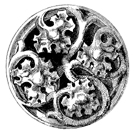
At Mass in Lenin’s City
AN ALTAR CONSECRATED BY PRIESTLY BLOOD
On Good Friday, March 30, 1923, Msgr. Constantine Budkiewicz of then-Petrograd, later Leningrad, now St. Petersburg, Russia, was executed by Lenin’s secret police. The police documents condemning this Catholic priest state that he “tried to shake the loyalty of the people [by urging them to oppose] the nationalization of [Catholic] Church property, the closing of churches and the requisition of articles of value.”
Later that year, Catholic Bishop Hodniewicz vanished into the gulags. Police records detail his crime: “Accused of resisting the expropriation of the valuables of the Church of St. Catherine at Petrograd on 24 June. When the Commissars Kolesnikov and Ivanov wished to examine a small altar furnishing in the tabernacle he declared that they would do it only over his dead body. Then he said to the faithful who were in the church, ‘Let us pray and let us keep them from touching the tabernacle except over our dead bodies.’… This crime is punishable according to Article 119 of the Penal code.”
Now 80 years later, after St. Catherine’s Cathedral was returned to Catholic ownership, I sat at Mass in front of the altar that both Budkiewicz and Hodniewicz died to defend. Fr. Maurice (a pseudonym), an American now resident in Russia, offered the city’s only English-language Mass for the week. His homily dealt with an unusual doctrine — salvation. He said to the 20 of us present: “Why are we not followers of Buddha or Mohammed? Because as Peter said to Jesus: ‘Only you have the words of eternal life.’ Without salvation Christianity is not Christianity, but some sort of philosophy of life. Many have forgotten this essential aspect of the faith. The result is a loss of zeal and even a loss of a sense of mission. What is the Church supposed to be seeking? As Pope Paul VI summed up for priests: our mission is glorifying God and saving souls.”
I’ve seldom heard back home such urgent concern for souls. Then again few American homilies are preached near altars consecrated by priestly blood. In a city once ravaged by secret police, summary executions, and gulag exiles, then by Nazi siege and mass starvation, and lately by loss of empire and economic collapse, people perhaps can be forgiven their unsophisticated interest in Heaven and Hell.
One side chapel has been fully restored as a shrine to Our Lady of Fatima, financed by American benefactors. But the other side chapel is more stunning. Its only adornment is a crucifix. A young girl had seen it thrown into the street by Lenin’s proletariat in the 1920s. She picked it up, hid it, and returned it to the church in the 1990s.
You May Also Enjoy
Love of neighbor may impel us to act like socialists, but we must not fall into the illusion that others' salvation is necessarily advanced from the charity shown them.
In the final analysis, can any of the objections voiced against his beatification stand up to the proof that God Himself intervened in the temporal world in response to the heavenly intercession of Pope John Paul II?
Ed. Note: During the 1985-1986 academic year, Henri J.M. Nouwen was a priest-in-residence at the…

